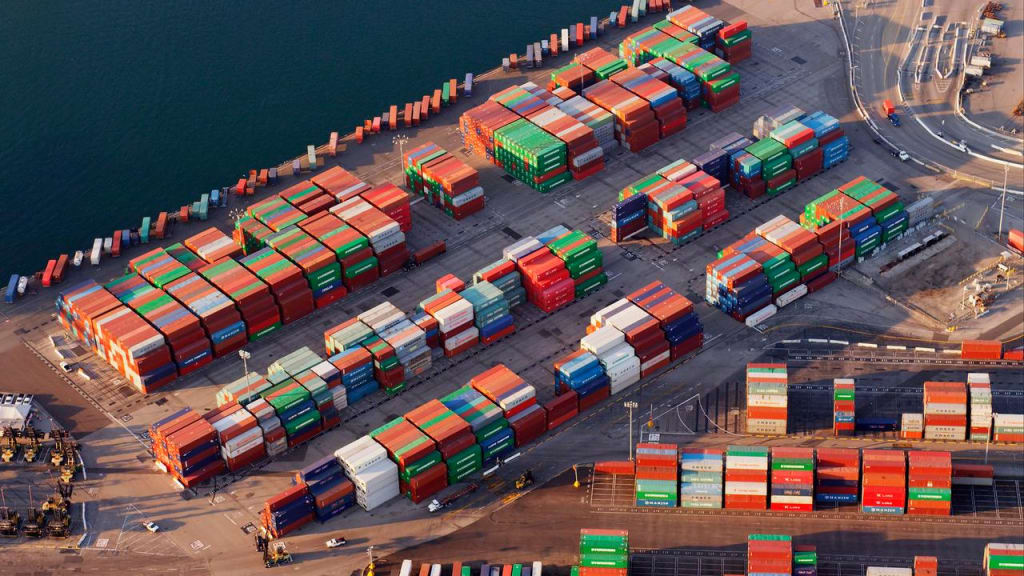The backbone of the global economy - mixed outlook for logistics groups

On Tuesday, 25.07.2023, Kuehne + Nagel presented figures for the first half of 2023. As expected, these were significantly weaker. Adjusted gross profit and net profit plummeted. After the Corona years, which were highly profitable for the industry, there are now signs of a normalisation of the market environment. Can the logistics groups stabilise again after the downturn?
A deep fall
At first glance, the figures presented by Kuehne + Nagel paint a worrying picture of the situation. Gross profit fell by 24 per cent in the second quarter to approximately 2.3 billion Swiss francs compared to the same period last year. In terms of profit, the company recorded an even deeper slump of 50 per cent to now 398 million Swiss francs. Nevertheless, the market reacted rather calmly to the figures, which was probably due to the fact that the slowdown in business was already expected by analysts. This is because the higher prices that the company was able to demand from customers during the Corona pandemic can no longer be enforced. This was already apparent in the previous quarter. One driver of the decline in gross profit was the difficult market environment in air freight. Air freight was the high flyer during the pandemic, as it was much more reliable than ocean freight. Now, however, the tide seems to be turning as air freight volumes are now declining. Although the overall market in sea freight also shrank slightly, this is less of a problem for Kuehne + Nagel, as the company operates much more efficiently in this area.
The conversion rate is one of the industry's most respected indicators of a logistics company's efficiency. It compares EBIT and gross profit and was around 24 per cent for Kuehne + Nagel in the first half of the year. In the first half of 2019, it was just under 13 per cent, indicating that the company has become significantly more efficient compared to pre-Corona times. To get back on track for growth in the future, the company is relying on a new strategy, which was presented in March under the name "Roadmap 2026". In the course of this, new growth potentials are to be developed in Asia, Africa and the Middle East. In addition, the management wants to focus more on offering profitable services. Whether this new strategy will have the desired effect is still unclear.
A look at the competition
DSV Group also presented its half-year figures on Tuesday (25.07.2023). These show that the logistics group from Denmark is struggling with similar problems as Kuehne + Nagel. This is because turnover fell by around 40 per cent in the second quarter compared to the previous year. Consequently, the company's profit also suffered significantly. This is due in particular to the decline in turnover in air and sea freight. A stabilising factor, however, is the land transport division, which recorded only minor losses. In addition, the conversion rate of 41.5 percent is well above pre-Corona levels. As DSV's management expects a slight recovery in trading volumes in the second half of the year, it slightly raised its earnings forecast for the full year. In the long term, CEO Jens Björn Andersen wants to grow through global corporate acquisitions and is therefore already in dialogue with some as yet unknown candidates.
Another major player from Denmark is A.P. Møller-Mærsk. The company operates in 130 countries and is a world leader in ocean freight, which accounts for about three quarters of the company's turnover. On 4 August, they released their report. Analysts are also expecting a decrease in turnover for Møller-Mærsk, although slightly less than expected. However, revenues came in slightly higher than expected.
In summary, it can be said that the slumps in turnover and profit for the companies in the industry may seem serious at first glance, but these are due to the end of the Corona boom and were already expected by the markets. In addition, the companies now seem to be operating much more efficiently. DSV's slightly higher outlook can possibly also be seen as a positive signal for the future. For investors who believe that business will stabilise in the coming months, a reverse convertible could be the right choice. This offers the possibility of realising an attractive coupon if the share prices of the companies trend sideways.

Risks
Disclaimer:
This information is neither an investment advice nor an investment or investment strategy recommendation, but advertisement. The complete information on the trading products (securities) mentioned herein, in particular the structure and risks associated with an investment, are described in the base prospectus, together with any supplements, as well as the final terms. The base prospectus and final terms constitute the solely binding sales documents for the securities and are available under the product links. It is recommended that potential investors read these documents before making any investment decision. The documents and the key information document are published on the website of the issuer, Vontobel Financial Products GmbH, Bockenheimer Landstrasse 24, 60323 Frankfurt am Main, Germany, on prospectus.vontobel.com and are available from the issuer free of charge. The approval of the prospectus should not be understood as an endorsement of the securities. The securities are products that are not simple and may be difficult to understand. This information includes or relates to figures of past performance. Past performance is not a reliable indicator of future performance.
© Bank Vontobel Europe AG and/or its affiliates. All rights reserved.
